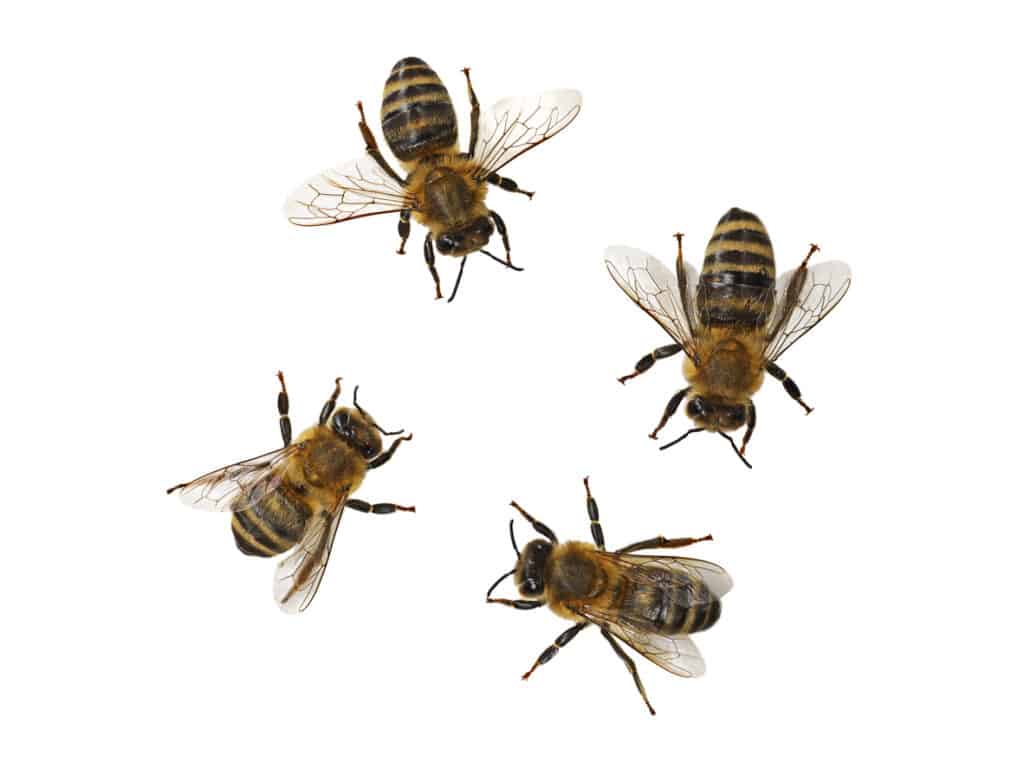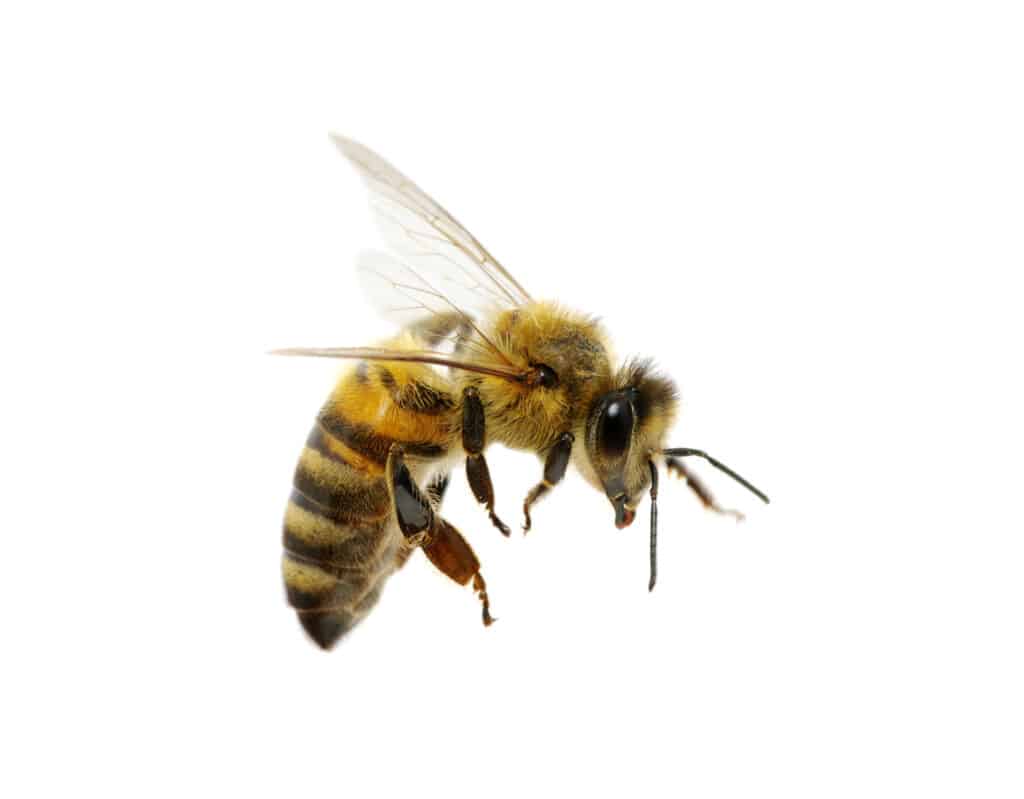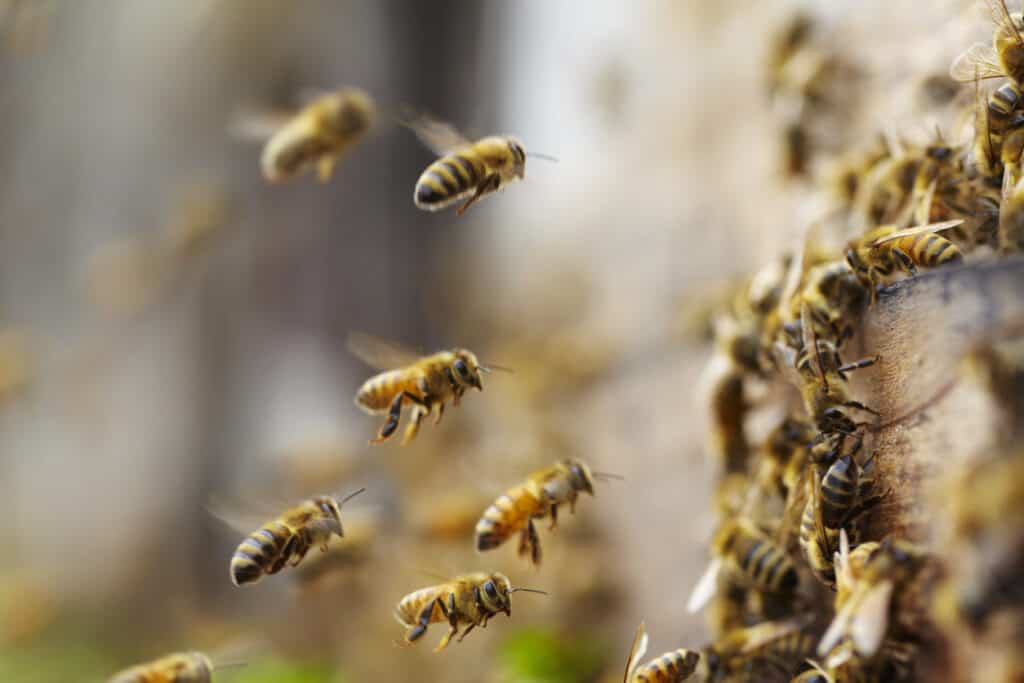You’ve probably been told that a bee is more scared of you than you are of it, which is true, as with most insects and animals. Perhaps you heard bees could sense your fear, and they intentionally sting scared people. One thing for certain is that bees have a great sense of smell, but can they sense when we’re afraid?
It is believed that bees can sense fear but not literally. Bees have an incredible sense of smell and communicate via smelling pheromones (chemical signals). Although there is currently no hard evidence, it is thought that bees can smell human fear pheromones.

It’s well known that bees are essential pollinators and industrious insects that secrete honey, but bees’ remarkable sense of smell is another fascinating characteristic. Smelling is a vital tool for bees, and humans are curious to find out why bees are drawn to people who are afraid of them and how bees react to our fear. Let’s investigate these creatures and how they sense fear.
Can Bees Detect Fear In Humans And Animals?

Bees are amazing insects for many reasons; one reason is because of their fantastic sense of smell. They use their noses (antennae) for various purposes such as communication and foraging for food.
Bees also use their antennae to recognize potential threats by sensing pheromones from other bees, humans, and animals. Bees can decipher between pheromones and act accordingly. They then give off their pheromone signals to alert other nearby bees.
Bees cannot literally smell fear as fear is odorless. They instead sense or smell the pheromones we give off when we are fearful. Unfortunately for us, bees interpret our fear pheromones as a threat, and you can’t blame them since most people are likely to swat them or start swinging our arms around.
It’s important to realize that bees don’t sting people who are afraid on purpose. They are not nasty creatures (using their stinger is a bee’s last resort); even if you are scared, you can do a few things to avoid being stung. Bees have an advanced olfactory system that allows them to add meaning to different scents.
Bees’ Sensitivity To Human Pheromones And Stress Sweat

Human pheromones are chemicals secreted by the body and affect the behavior of other humans. They are present in sweat, saliva, and urine and can be detected by the nose. Pheromones influence various human behaviors, including attraction, stress, and aggression.
Stress sweat is a type of sweat that is produced when a person is under stress. It contains higher levels of cortisol, which is a hormone that is associated with stress.
When a person smells stress sweat, they may feel anxious or stressed themselves. This is because the smell of cortisol activates the sympathetic nervous system, which controls the fight-or-flight response.
Bees are sensitive to human pheromones. In one study, bees were more likely to sting someone who had already been stung than those who had not. This suggests that bees can detect fear in humans through their sense of smell.
It is not clear exactly how bees use their sense of smell to detect fear in humans. One possibility is that they can detect cortisol in sweat. Another possibility is that they can detect changes in body odor that occur when a person is under stress.
How Do Bees React To Fearful Humans And Animals?
When a bee detects a threat, it may act aggressively, chase after you and even sting you. If you are near a beehive, the bee will most likely alert the colony by releasing an alarm pheromone. If the colony has determined that you are a threat, they might swarm and attack you.
The alarm pheromone is just one of many different pheromones that bees use to communicate with one another. Bees use pheromones for various purposes, including communication, navigation, attracting mates, marking food sources, and defense.
Pheromones are also used to determine the social hierarchy within a hive. The queen bee produces a unique pheromone that suppresses the reproduction of other bees in the hive. This ensures that she remains the only fertile female in the hive and that her offspring will inherit her throne.
There is no doubt that the best thing to do if you find yourself under bee attack is to remain calm. Don’t run or panic but rather slowly remove yourself from the situation. Try not to be fearful, as this will escalate the situation, and more bees will become aggressive.
Even though bees act aggressively towards a threat, they are being defensive. Bees are most defensive when they feel their hive is at risk of damage. Most bees, such as honey bees, will only sting if you intentionally try to harm them or their hive.
Otherwise, they will usually try to get away from you as long as you remain calm and don’t panic. Some exceptions exist; some species of bees are much more dangerous and volatile, such as the Africanized honey bee.
How Bees Use Their Sense Of Smell For Their Defense?
All bee species produce alarm pheromones, but they vary in strength and duration. For example, Africanized honeybees (also known as “killer bees”) produce alarm pheromones that are much more potent than those produced by European honeybees. As a result, Africanized honeybees are much more aggressive than European honeybees when they perceive a threat.
When bees detect an alarm pheromone, they respond by attacking the source of the pheromone. This behavior is known as “defensive swarming.”
Defensive swarming is the most dangerous type of bee aggression, and it can be fatal to humans if enough bees are involved. Fortunately, most bee species do not produce alarm pheromones that are strong enough to trigger defensive swarming behavior in other bees.
How Are Bees Able To Sense Fear?
When humans or animals are frightened, pheromones are produced and released into the air. Our mouth’s palate is responsible for sensing other humans’ pheromones and sending them to our limbic system. The limbic system is the region in our brains that processes emotions.
In most cases, only members of the same species can sense another member’s pheromone signals. Bees are an exception to this rule since they can detect pheromones from other animals and humans.
A bee’s sense of smell is similar to a human’s. Just as humans have an olfactory system that manages different scents and sends signals to our brains, so do bees, although a bee’s olfactory system isn’t as advanced.
You may have seen how a bee touches flowers with its antennae – the bee is smelling the flower. Bees’ antennae are covered in tiny hairs called sensilla, allowing them to detect changes in the air around them. Bees also love strong aromatic scents, which is why they are often attracted to flowers such as lavender.
Bees have compound eyes made up of many small eye units called ommatidia. Each ommatidium allows the bee to see in a slightly different direction, giving them a wide field of view but not providing them with sharp vision. Instead of seeing clearly, bees see patterns of light and dark.
Bees have special organs in their feet called Johnston’s organs, allowing them to detect vibrations in their environment. These vibrations could be caused by something as small as an insect walking on the ground or something as significant as a predator approaching the hive. By detecting these vibrations, bees can warn others in the hive of potential threats and help them prepare for an attack.
How Do Bees Make Use Of Their Sense Of Smell?
When foraging for food, bees use their sense of smell to identify the type of flower they visit and determine whether it contains nectar or pollen. By smelling the flowers, bees can also decide which ones have been visited recently by other bees and which ones are likely to have more nectar or pollen available.
Bees communicate using pheromones, chemical signals that convey information about the bee’s identity, location, and state. For example, when a bee finds a good food source, it will leave behind a pheromone trail that leads other bees to the same spot.
Do Bees Only Communicate With Pheromones?
No, bees also communicate using other methods. For example, they use visual cues to share the location of food sources. They also use touch to communicate, especially when grooming one another.
Sound is another essential method of communication for bees, and they use it to communicate both within the hive and to other animals outside the hive. Body language is also an important form of communication for bees; they use it to convey various messages, including aggression, submission, and courtship.
Why Do Bees Attack?
Bees are naturally defensive creatures. They will attack to protect themselves and their hive when they feel threatened. There are a few reasons why bees might attack humans or other animals.
One reason is if the bee feels like its territory is being invaded. If a bee feels like its personal space is being infringed upon, it may become aggressive to drive the perceived threat away. This is why it’s essential to be careful when you’re around a bee hive – if you accidentally disturb the bees, they may attack you in defense of their home.
Another reason bees might attack is if they think you’re a predator. Some predators, like wasps and hornets, are known to raid beehives for honey. To a bee, an animal approaching its hive could be seen as a threat to the colony’s safety.
Bees will also attack if they feel their lives are in danger. If a bee perceives that it’s about to be harmed, it may sting to protect itself. This instinct is particularly strong in worker bees, willing to sacrifice their own lives to defend their hive from harm.
Of course, not all bees are aggressive – many species of bees are pretty docile and unlikely to sting unless they feel threatened. It’s important to remember that each bee is different, and some are more prone to aggression than others.
How To Avoid Bee Attack And Being Stung
Bees are attracted to movement, so it is important to stay still if you see one near you. Bees will usually only sting humans if they feel threatened, so it is crucial not to swat at them or wave your arms around.
If a bee does land on you, gently brush it off without squashing it.
If you wear brightly colored clothing, bees may mistake you for a flower and try to land on you. Wearing darker colors can help to avoid this. If you are outside in an area with bees, try to avoid wearing perfumes or scented lotions, as these can attract them.
You can do a few things to avoid being attacked by bees. First, try to avoid areas where bees are known to congregate. If bees fly near you, stay still and let them fly away.
Finally, if a bee does sting you, quickly remove the stinger by scraping it off with your fingernail or a blunt object like a credit card. Do not pull the stinger out using your fingers, as this can release more venom into your system.
Bee stings can be dangerous to humans if someone is allergic to bee venom or if they are stung multiple times. When a bee stings, it injects a venomous substance into its victim through a hollow needle-like structure called an ovipositor. This venom causes swelling and pain at the sting site.
Will Bees Sting Pets?
Bees are generally not aggressive towards pets, but there are a few exceptions. If a bee feels threatened or agitated, it may sting in self-defense. This is more likely to happen if the bee is defending its hive or nest, but it is possible for an individual bee to become agitated and sting without provocation.
While uncommon, there have been cases where bees attack and sting pets. One such incident happened in Arizona in 2012 when a swarm of bees attacked and killed a dog. The bees were protecting their hive from perceived threats.
In another incident, a group of bees stung and killed a cat in New York state. In both situations, the animals were most likely not aggressive toward the bees but were antagonistically too close to them.
If you have a pet acting aggressively towards bees, it is essential to try to keep them calm and under control. If they are stung, they may experience pain and swelling at the site of the sting.
An allergic response can be fatal and can occur in rare situations. If you think your pet has been stung by a bee, it is vital to seek medical attention immediately.
Can Other Insects Smell Fear?
Other insects can certainly smell fear, but not in the same way bees do. For example, ants use their sense of smell to track down food sources and detect fear pheromones in other animals.
However, they don’t seem to use this ability to target afraid individuals. Instead, they use it to avoid areas where predators may be present.
Termites are another example of an insect that can smell fear. They can distinguish between different types of fear pheromones.
For instance, one kind of pheromone is released when a predator attacks a termite. Another is released when a termite encounters a dangerous situation (such as being trapped in a closed space).
Again, however, there is no evidence that termites use their sense of smell to target individuals who are afraid. So why do bees seem to be the only insects that use their sense of smell to target afraid individuals? One possible explanation is that bees have evolved this ability specifically for defense purposes.
Conclusion
In conclusion, bees can sense fear in humans and other animals. This is because they can smell our pheromones released when we are afraid. The bees don’t know we are scared; they interpret our fear pheromones as a threat.
While not all bees are aggressive, those that are can be very dangerous. If a swarm of bees ever attacks you, it is essential to remain calm, keep still, and seek medical help immediately if stung.
References:
https://www.trvst.world/biodiversity/can-bees-smell-fear/
https://grampashoney.com/can-bees-smell-fear/
https://honeybeehobbyist.com/can-bees-smell-fear/
https://busybeekeeping.com/can-bees-smell-fear/
https://schoolofbees.com/can-bees-smell-fear-the-complete-answer/
https://www.beekeeping-101.com/are-bees-really-able-to-smell-fear/

